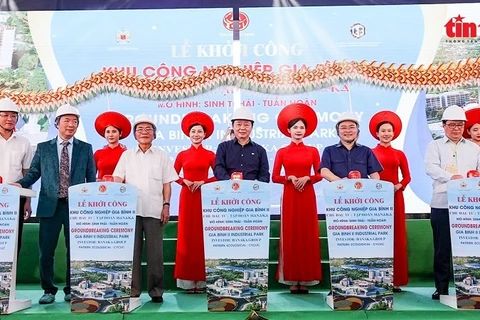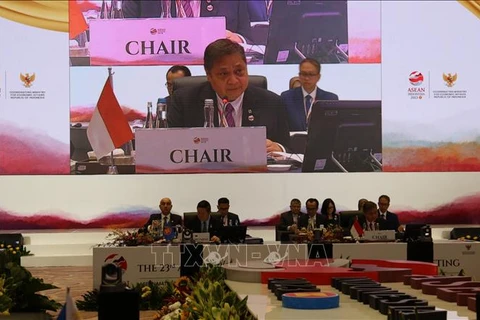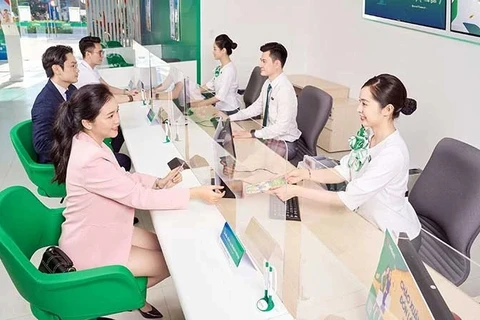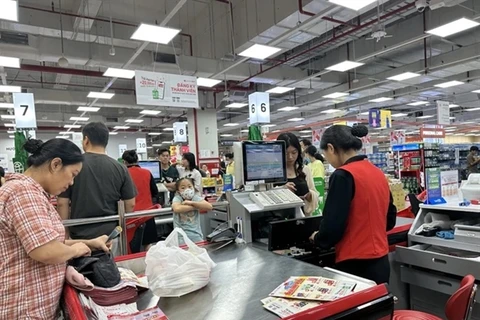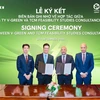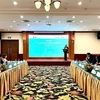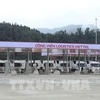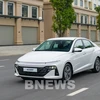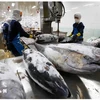 Dr. Pham Hong Diep, Chairman of the Board of Directors and General Director of the Shinec Joint Stock Company – developer of the Nam Cau Kien Industrial Park (Photo: VietnamPlus)
Dr. Pham Hong Diep, Chairman of the Board of Directors and General Director of the Shinec Joint Stock Company – developer of the Nam Cau Kien Industrial Park (Photo: VietnamPlus) Hanoi (VNA) – With its ecological infrastructure, the Nam Cau Kien Industrial Park was selected by the Tourism Department and the Education Department of Hai Phong northern city as one of the 19 sightseeing places for local students to experience and learn from. The pilot implementation of the eco-industrial park model in Vietnam has recorded positive results and initially generated economic, social, and environmental benefits.
The Nam Cau Kien - Shinec Eco-Industrial Park, based in Thuy Nguyen district of Hai Phong, is considered one of the best models nationwide in terms of green and sustainable development.
Dr. Pham Hong Diep, Chairman of the Board of Directors and General Director of the Shinec Joint Stock Company – developer of the Nam Cau Kien Industrial Park, granted an interview to VietnamPlus about the park’s circular economy model.
Welfare for buffer zone
- Nam Cau Kien is the first locally invested eco-industrial park in Vietnam that harmoniously combines environmental protection and a circular economy ecosystem. Could you share more information about the basis for developing this project?
Dr. Pham Hong Diep: Aside from natural conditions such as the geographical location, climate - weather, and land - soil - water resources, we conducted human resources surveys right from the first stage (in August 2007) with nearly 19,000 households whose land was revoked to serve the project. Among them, 74% lived on agriculture. In particular, the first target of this project is to ensure jobs and income for the families to prevent poverty.
For example, a six-member household comprises an elderly couple aged 60 - 70, their son who is a worker with monthly income averaging 2.5 million VND, his wife who became jobless after land revocation, and two small children still attending school. Their six “sao” of rice fields (one “sao” is equivalent to 360sq.m.) were revoked, and now their remaining property is a house and a garden covering two “sao”. With local practices and the existing area, that family earns at least 6 million VND per month to guarantee their life and children’s study.
This is a typical example based on which a mass production model is developed in the entire surrounding area of the industrial park. On that basis, Shinec carried out a project on developing an agricultural buffer zone to create conditions for residents in the communes where land was revoked to promote household-scaled crop and animal farming. They also formed farm models to ensure sustainable interests between the park and nearby farmers.
 Shinec has built a complete food distribution system from orientation setting, production to assessment and purchase with a view to distributing food from producers to consumers to ensure harmonious interests among parties and sustainable development. (Photo: Nam Cau Kien Industrial Park/VietnamPlus)
Shinec has built a complete food distribution system from orientation setting, production to assessment and purchase with a view to distributing food from producers to consumers to ensure harmonious interests among parties and sustainable development. (Photo: Nam Cau Kien Industrial Park/VietnamPlus) Shinec has transferred scientific and technological advances to help locals optimise abandoned land. It also helped them improve the environment by taking new technical measures and carry out alternative crop and livestock farming. These moves will help to secure high-quality and diverse food sources to meet food demand in the local community and the Nam Cau Kien Industrial Park. Shinec has built a complete food distribution system, from production to assessment and purchase. The idea is to distribute food from producers to consumers to ensure harmonious interests and sustainable development among parties.
A circle has beginning but no ending
- Could you give more details about the symbiotic industrial process implemented in the Nam Cau Kien Industrial Park to ensure circularity, protect the environment, and promote production and business activities?
Dr. Pham Hong Diep: The progress of a circular economy is a circle that can begin but does not end. Based on overall studies of the situation of industrial parks in Vietnam and the surveys and assessments of the pilot model at the Nam Cau Kien Industrial Park, it could be said that circular economy in industrial parks is a symbiotic model of a group or a community of businesses. They make use of satellite resources and resources directly involved in protection to create a sustainable circulation of materials.
During the whole symbiotic process, the management boards, or developers of industrial parks play an important role. They help determine production towards the balance among the three pillars of economy, environment, and society. We are setting up a vision with three circles: the first is the symbiotic model in the industrial park (core circle), the second is a regional symbiotic model (for example a symbiotic model among industrial parks in Hai Phong), and the third is the one of connectivity that spreads across the country.
Given its eco-industrial park characteristics, Nam Cau Kien can meet criteria of both circular economy approaches: according to the size of the economy/geographical spaces, and according to sectors or groups of products and materials.
 The Nam Cau Kien Industrial Park has connected production and business activities to form material circulation in a certain economic space. (Photo: VietnamPlus)
The Nam Cau Kien Industrial Park has connected production and business activities to form material circulation in a certain economic space. (Photo: VietnamPlus) First, in terms of the size of the economy (or geographical spaces), there are many levels which could be an economy at the local level (industrial parks, cities, provinces) or at the regional (inter-provinces, inter-cities), national, or even inter-national levels. At the local level, the Nam Cau Kien Industrial Park has connected production and business activities. This forms material circulation in a certain economic space (within this industrial park, and between businesses at the Nam Cau Kien Industrial Park and those in other places or outside socio-economic activities).
In the future, Nam Cau Kien holds potential to develop circular economy at the regional level as other localities like Quang Ninh, Gia Lai, Hau Giang, and Khanh Hoa are planning to expand and build industrial parks.
The second is the approach according to a certain space or economic system, with a focus on sectors or groups of products or materials. In fact, industrial production activities at the Nam Cau Kien Industrial Park follow this method, creating symbiotic industrial circles for key sectors.
Green forest in industrial park
- A bright spot making a difference in the Nam Cau Kien Industrial Park is the attention to the natural environment and the heritage factor. Could you explain this issue further?
Dr. Pham Hong Diep: The Nam Cau Kien Industrial Park, covering 263ha, accommodates more than 80 businesses operating in various fields and sectors. Every impact, regardless of big or small, affects the ecosystem. However, the industrial park targets smart planning, its space harmoniously connected with the nature, and minimises the impact on the environment.
The importance of biodiversity in an industrial park is extremely considerable and related to economic development. Aware of this issue, Nam Cau Kien has formed a new natural ecosystem amid an industrial environment. In its planning, functional zones are closely connected with one another in a way that ensures their functions are performed and the environment is protected, ensures the safe distance from nearby residential areas, and minimises impacts on the local land status.
 The industrial park targets smart planning, its space harmoniously connected with the nature, and minimised impacts on the environment. (Photo: Nam Cau Kien Industrial Park/VietnamPlus)
The industrial park targets smart planning, its space harmoniously connected with the nature, and minimised impacts on the environment. (Photo: Nam Cau Kien Industrial Park/VietnamPlus) In particular, the park has a reasonable density of construction facilities among which lines of trees and canals along roads are arranged. Its transport system was also built flexibly and comprehensively to create a green and modern industrial park. As a result, trees and water bodies like canals and lakes have helped guarantee a fresh and friendly landscape. They minimise the spread of pollutants to the environment and make the climate in surrounding areas equable.
In the park’s design, businesses of different sectors are given suitable locations. For example, the park accommodates companies treating waste and by-products by environmentally friendly technology. They do this by meeting the treatment demand as soon as possible to minimise waste discharged to the environment. On that basis, projects in the industrial park must have at least 20% of their area covered by trees. Nam Cau Kien has also fully complied with the regulation that the land area for trees, transport, technical sections, and social infrastructure for common use must account for over 25% of the total zoned area. Thanks to that, plants in the industrial park are still growing well.
 With its ecological infrastructure, the Nam Cau Kien Industrial Park was selected by the Tourism Department and the Education Department of Hai Phong city as one of the 19 sightseeing places for local students to experience and learn from. (Photo: VietnamPlus)
With its ecological infrastructure, the Nam Cau Kien Industrial Park was selected by the Tourism Department and the Education Department of Hai Phong city as one of the 19 sightseeing places for local students to experience and learn from. (Photo: VietnamPlus) In addition, the park has worked to enhance ecological diversity by introducing new plants to the area. These include more than 150 flower species, over 500 perennial tree species, 50 fruit tree species, and tens of hectares of grass, bushes and water surface with a diversity of aquatic species such as fish, shrimp, crab, moss, and plankton.
According to the company’s estimates, the volume of gas emissions cut thanks to trees here is about 7,000 tonnes of CO2 each year. The emissions cut thanks to solar power panels installed across the industrial park is up to 40,000 tonnes of CO2 each year. The land improvement, pollution reduction, and combination of environmentally friendly landscapes have helped better land effectiveness and value. The reduction of all pollution sources to zero aims to protect the environment for the health of people and all living things in the industrial park.
- Thank you very much!
